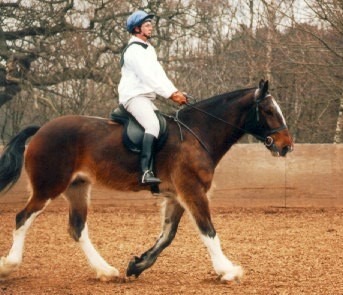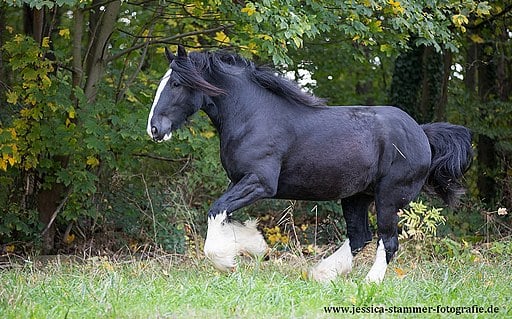Last updated: October 17, 2023
When you think of riding horses, the most likely image in your head is of a sleek Thoroughbred or Quarter Horse. But what about the Shire horse breed? Are these old-fashioned workhorses good for riding?
Shires can make excellent riding horses. Thanks to their calm dispositions, Shires are often used in therapeutic riding programs. They are known for their large size and gentle temperament, which makes them a good choice for riders of all ages and experience levels.
While Shires may not be the fastest horses on the track, they are sure-footed and reliable, two qualities that are prized in a riding horse. For these reasons, Shires make an excellent choice for those looking for a dependable mount.
Many people think the Shire breed is limited to pulling heavy loads, and they would be mistaken. There are actually a lot of activities this horse breed does, and pulling is just one.
Shire Horses Are Suitable for Any Level of Rider.
Shire horses have an excellent work ethic, a calm disposition, and are willing horses. These animals make great riding horses and are suitable for any level of rider.

Shires provide an excellent seat for large riders; they’re powerful and travel effortlessly. They want to please and learn, and under the guidance of an experienced horse trainer, they learn quickly.
And once the Shire is trained correctly, they are patient and can be ridden by any level of rider. They move exceptionally well and have a kind, gentle nature, which makes them a desired breed for therapeutic riding.
The Shire is very smooth riding horses. The transition from walk to trot to a slow loping canter is graceful, and the gaits don’t jar their rider. And without realizing it, you cover a lot of ground quickly with each of their long strides.
Draft horses work from oral cues. If you’ve witnessed a man and horse plow a field, you likely remember the driver verbally directing his animal continuously with various sounds.
Their reaction to verbal commands illustrates the breeds’ intelligence, and these transition well to horseback riding when trained correctly. The Shire quickly learns basic commands that increase the pleasure of riding.
The size of a Shire horse does cause some difficulties when riding.
Shire horses are enormous animals, and their size does raise some complications. The first challenge is to tack your horse. But hopefully, you’ll have assistance from a hand experienced with draft breeds.
The next obstacle their bulk presents are mounting. This draft breed is extraordinarily tall, which makes it virtually impossible to step into the saddle stirrups without aid.
Once in the saddle, you’ll be able to comprehend their magnitude. Your legs are spread wide and are elevated way above a typically sized animal. The width of their back could be a comfortable seat for tall, long-legged people, but for most, it’s uncomfortable.
The Shire’s girth makes it difficult for most of us short people to ride and train them with leg ques. But overall, Shires don’t need too much encouragement and are eager to move along when asked.
Stubborn horses are difficult to control because most riders are not accustomed to handling large draft breeds. When a standard-sized horse begins acting up, it’s natural to pull its head to one side and take away its power.
Only with a severe bit could you pull a Shire’s head around when it doesn’t want to bend. Luckily these horses are patient and have the desire to cooperate; otherwise, they would be more than a handful to control.
The Shire Horse makes an excellent trail riding mount.
Shire horses are calm and patient, and these are essential traits for a trail-riding horse. We take a few long trail rides each year, and one thing I’ve learned is it’s of paramount importance to be on the back of an animal that doesn’t spook easily.
When you ride in public spaces, the unexpected yapping dog, wild animal, or breakaway horse is going to challenge you. There are so many odd things that can happen on a trail ride that it’s critical, you’re riding an animal with a calm disposition and won’t try to bolt when provoked.
Shire horses don’t spook. When everyone else is fighting to control their horses because a pack of dogs is barking at the horses, you will appreciate that you are sitting on a cold-blooded draft breed. Skittish horses ruin trail rides.
The paths you ride may include rugged terrain or be blocked by fallen trees. No problem for the Shire, these big horses are sure-footed and can easily step over logs and debris.
How Much Weight Can a Shire Horse Carry?
A typical Shire horse can easily carry 400 lbs. Fit horses are recommended to be burdened with no more than 20 percent of their body weight, and most Shires weigh over 2,000 lbs.
Don’t forget to calculate the weight of the saddle when determining how much weight to put on your horse. A typical western saddle weighs 45 lbs, and an English saddle is close to 20 lbs.
Certain breeds, donkeys, and mules comfortably carry 25 percent of their body weight. The Shire descended from the “Great War Horses,” which often carried men in full battle armor that weighed as much as 400 pounds and are naturally strong animals.
They may be able to carry more than 20 percent of their weight. If you elect to exceed 20 percent, be sure and watch for signs the horse is not overburdened. Some signs your horse is overworked are excessive sweating, increased heart rate, and a sudden change in demeanor.
Shire horses crossbred with sports breeds make suitable dressage horses.
Any breed can compete in dressage, and the Shire crossed with lighter breeds have fared well in competitive dressage. But there’s also been purebred Shires to compete in lower-level dressage as well.
Shires are giant draft breeds for sure, but they aren’t clumsy, just the opposite; they are athletic and smooth. They have the correct temperament for dressage.
They compete and have the desire to please their owners; they don’t mind hard work and have a presence in the arena. However, they are just too large to compete in top-level dressage.
The Shire Horse Breed
The Shire horse is a British breed of draft horse. It is the largest and strongest of the British heavy horses and was once used for pulling carts and plows. Shires are usually black, bay, or grey and stand at around 17 hands high.
They are known for their gentle nature and have a long lifespan of around 30 years. Shires are now mostly used for riding and driving, although some are still used for seasonal work such as forestry and farming. The Shire Horse Society was founded in 1878, and there are now around 5000 Shires in the UK.
Shire horses originated in England.
Shire horses originated in England and are believed to be descended from the “War Horses” of the European continent. Before the introduction of the “War Horse,” English horses were small. The “Packington Blind Horse,” is the foundation stallion of the breed. It stood at Stud from 1755 to 1770. These horses were primarily used to pull carriages and transport goods.
Shires first made their way to the United States in the mid-1800s, and by the end of the century, the American Shire Horse Association was established. Shire horses were the perfect animal to use on farms. They were strong, smart, and fast. Because of these attributes, they quickly replaced oxen in many areas.
In England, these mighty draft horses proved their worth towing barges up and down canals. But the industrial revolution ushered in the age of the steam and combustible gas engine, which drastically reduced the need for draft horses.
Modern Shires are commonly used for recreational riding, dressage, and trail riding. Some of the horses are still used in typical draft occupations such as forestry, farming, and pulling carriages.
Breed Characteristics
Shire horses are a massive draft horse breed that was once used extensively in industry and agriculture. Shires were particularly valued for their strength and size, but they are also recognized for their gentle nature and calm temperament. Shires are also known for their feathered feet, which help to protect them from the cold and wet weather.
Colors of Shire horses
The American Shire Horse Association accepts the following colors for registration: Black, brown, bay, gray, or chestnut/sorrel (rare) are the preferred colors.
The Shire typically has white socks and a blaze or nip on its face, but excessive white markings and roaning are undesirable.
Height
Shires typically stand between 17 and 19 hands high, making them one of the tallest horse breeds in the world. According to the American Shire Horse Association, the average stallion is 17 hands tall.
Shire stallions under 16.2 are not accepted for registration. Shires are among the largest breeds in the world. They are also characterized by their thick necks, broad chests, and short backs.
The record for the largest horse was the Shire named Mammoth. He stood at 21.2 hands and weighed in at about 3,300 pounds.
Temperament
Despite their large size, Shires are actually known for being relatively gentle and easy to handle. As a result, they are often used in therapeutic riding programs or as parade horses. Shires are truly a unique and majestic breed of horse.
Shires are calm, patient, and easygoing. They are people-oriented and have a desire to please. Kind and gentle is the most common terms used to describe these animals, other than massive.
Below is a YouTube video showing a person riding a Shire horse.
Related Articles:
- Black Forest Draft Horse: Facts and Breed Characteristics
- Percheron, A French Draft Horse Breed: Facts, Colors, & Uses
- The Unique Horse Breeds Used in Warfare.
- Are Belgian Horses Bigger Than Clydesdales? Both are Huge!
- The Epic Battle: Mule vs. Horse. Which Is Best For You?

About the Author: Miles Henry
Lifelong Horseman | Racehorse Owner | Published Author
Miles Henry brings over 25 years of hands-on experience training and owning Thoroughbred racehorses. Raised with Quarter Horses and Appaloosas, he’s spent a lifetime learning from horses—on the track, in the barn, and in the field. Today, he runs a small but successful racing stable in Louisiana and shares real-world insights on HorseRacingSense.com, helping horse owners, fans, and bettors navigate the sport with confidence.
📚 Books: View Miles’s books on Amazon »
🎧 Podcast Guest: Animal Tales Ep. 32 |
YouTube Interview
📩 Newsletter: Sign up for racing tips and horse care advice »
🔗 Follow Miles:
Twitter |
Facebook |
YouTube



